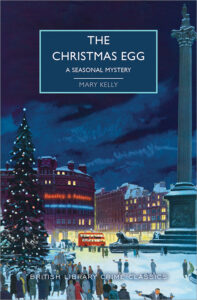The Christmas Egg, first published in 1958, is an unconventional Christmas crime novel by an unconventional writer. Mary Kelly was one of the most talented British novelists to write crime fiction in the post-war era, coming to the fore just before P.D. James and Ruth Rendell appeared on the scene. Having risen rapidly to the heights, she abandoned the genre after publishing a mere ten books over a span of eighteen years. Her disappearance from the scene was as mysterious as it was complete; she did not publish a novel after 1974, even though she lived until 2017.
This was her third book. Like its predecessors, A Cold Coming and Dead Man’s Riddle, it featured Detective Chief Inspector Brett Nightingale. In the run-up to Christmas, he is confronted by the puzzle of the death of the elderly Princess Olga Karukhina, who had fled her native Russia in the wake of the Revolution. But this is not an elaborate whodunit in the tradition of Agatha Christie or Dorothy L. Sayers. Nor is it a police procedural novel of the kind that John Creasey had popularised in the 1950s. Kelly’s principal focus is on the study of character and on the idiosyncrasies of British society.
The idea for the story came to her after she was sent, in error, a set of books about Russia to review. The books were meant to be sent to Marie-Noelle Kelly, and this prompted Mary Kelly to read the work of her not-quite-namesake. This in turn led her to attend an auction of Fabergé eggs. Her knowledge of Islington, an important setting in the story, came from evening walks in the neighbourhood after she and her husband had visited the opera at Sadlers Wells.
When, eight years after its original appearance, the novel was finally published in the U.S., the eminent American critic Anthony Boucher lauded it in his column in the New York Times. Noting that Nightingale was an amateur tenor, he described him as an “unusually attractive” character. For Boucher, the book was “fascinating as a stage in the development of an important writer, and a pleasing entertainment in its own right.” Kirkus Reviews also approved the novel, pointing out that the story involved “more pursuit than procedure,” and saying it was “easy to read, fast to follow, with no remission of interest.”
Mary Kelly’s love of music is evident in much of her fiction, including The Christmas Egg. She was an enthusiastic singer, a mezzo-soprano with an extensive knowledge of lieder, capable of singing Schubert’s song cycle from memory. Brett Nightingale’s wife, Christina, was an opera singer, and Mary gained insights into the life and work of professional singers from Monica Sinclair, a member of the Covent Garden Opera Company who was Sir Thomas Beecham’s preferred choice as contralto. Critics who shared Kelly’s devotion to opera, and derived particular pleasure from her work, included two notable commentators usually associated with the classic whodunit rather than the psychological crime novel, namely Boucher and the composer Bruce Montgomery, better known as the detective novelist and Sunday Times reviewer Edmund Crispin.
The Christmas Egg consolidated Kelly’s developing reputation as a quirky, intelligent crime novelist, but she was never interested in following fashion or working to a template. Later, in an excess of modesty that seems typical of her, she would describe the three Nightingale books as “sins of my youth.” She wrote a novel without Nightingale, Take Her up Tenderly, which was rejected and never published. Her next book, which appeared in 1961, was very different, and it heralded a breakthrough in her literary career.
The Spoilt Kill was set in the Staffordshire Potteries, and had a workplace setting as memorable as it was unusual. The protagonist was an enquiry agent called Hedley Nicholson, but he was as unlike, say, Sam Spade or Philip Marlowe as Nightingale was unlike Freeman Wills Crofts’ Inspector French or Ngaio Marsh’s Inspector Roderick Alleyn. The book was critically acclaimed and won the Crime Writers’ Association Gold Dagger for the best crime novel of the year, which was presented to her by Sir Compton Mackenzie. Given that in winning the prize, Kelly’s book edged out John Le Carre’s Call for the Dead, which introduced the now legendary George Smiley, the scale of her achievement is clear. She was promptly elected to membership of the prestigious Detection Club at the age of thirty-four; later, she became the club’s secretary.
In reviewing The Christmas Egg, Boucher expressed the hope that Nightingale would return. What he (like almost everyone else) failed to realise is that, in a very oblique passage in The Spoilt Kill, Kelly had effectively killed off her first series detective in a car crash. Nicholson reappeared in her next novel, but he, too, was quickly abandoned. After that, she concentrated on writing stand-alone novels, and although her style was too understated for her ever to achieve bestseller status, she retained a devoted coterie of admirers. Edmund Crispin was among them, enthusing over Write on Both Sides of the Paper (1969): “her insights into human behaviour are tethered, wonderfully effectively, to the availability of spending money and the frequency of buses… Such conscientiousness may sound dull. In fact, however, it is all in a flight with the gentle, witty, profound acuity with which her characters are treated.”
Yet there was something willful, as well as something admirable, about the way that, throughout her career as a novelist, Mary Kelly defied the conventions and commercial imperatives that guide the fortunes of almost all writers. Her publishers, not surprisingly, began to despair of her. So did some critics. Even her admirers admitted to some frustration. An example was H.R.F. Keating, who opened an essay about her books in Twentieth Century Crime and Mystery Writers as follows: “One of the best contemporary British crime writers, but: such must be the verdict on Mary Kelly.” Keating regretted the fact that she published so infrequently, and felt that she skimped sometimes on plotting, but emphasised that “there is enormous pleasure to be got from her books…what propels the reader through the pages is…the sheer excellence of the writing…from her very first sentence Mary Kelly observes so meticulously, describes so exactly and economically. Hers is a never-blinking eye.”
Mary Theresa Coolican was born in London on 28 December 1927. She was educated at a convent and at Edinburgh University, where she met her future husband, Denis Kelly (to whom I am indebted for sharing his loving and fascinating memories of her). After marriage and grad- uation, she worked as an auxiliary nurse and, like Denis, as a teacher; her first permanent post was as a teacher of Latin and English at the Convent of the Handmaids of the Sacred Heart of Jesus in Beckenham.
She enjoyed detective fiction, including the novels of Michael Innes and Dorothy L. Sayers, and the clear struc- ture of the classic genre appealed to her; she often likened the “Golden Age of Murder” between the wars to the era of sonnets and sonneteers. At one point, her publisher promoted her as “the new Dorothy L. Sayers”, but this was wide of the mark. Mary Kelly’s writing was nothing like Sayers’, far less Christie’s. Satisfaction with the plots of her books always eluded her.
For a novelist with such gifts and potential, That Girl in the Alley (1974) marked a low-key and anti-climactic end to her career as a published novelist; thereafter just one short story appeared, in an anthology in 1976. She decided to set her next book in Prague, and researched the manufacturing of cellos for the background. Unfortunately, she felt dissatisfied with the new novel, and although she kept working at it, off and on, over several years, she never finished it.
Mary Kelly enjoyed socialising with fellow crime writers; her friends included such disparate characters as Patricia Highsmith, Anthony Berkeley, William Haggard, Josephine Bell, John Trench, Joan Aiken, and Michael Gilbert. At one point, when Michael Innes had lost interest in the Detection Club, she persuaded him to re-engage. But she became deaf relatively early in life, and as time passed, she lost touch with her colleagues and the genre.
Instead, she pursued other interests. She and Denis were keen botanists, and she enjoyed decorating and gardening. They started renovating houses, selling up, and starting all over again, before eventually settling in Bath. In her seventies, she decided to write another book. The inspiration was the nursery rhyme “Ding dong bell.” The story was to concern a drowning in a well in Surrey, and was meant to be slyly comic. Regrettably, she did not finish it before illness intervened.
As a writer, Mary Kelly was one of a kind. It’s clear from reading her work, including The Christmas Egg, that she admired courage and honesty, and these are qualities that she manifested in her personal life. There are no locked room mysteries in her novels, no elaborate puzzles or plot twists, and no eccentric crime-solving genius. But in their quiet, polished way, her best books deserve to be ranked as crime classics.


















